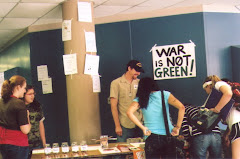


On Saturday, I went out to the "Slam Bowl" fundraiser for the Texas Youth Word Collective - which was great. The four poets who comprise this year's "They Speak" slam team performed several team poems that they are bringing to the Brave New Voices International Slam next month, hosted this year in Los Angeles. Always, these young poets do Austin proud.
The TX Youth Word Collective sent out this message about their plans:
Dear Supporters & Friends,
It’s that time of year again and the Texas Youth Word Collective is scrambling to raise the necessary funds to take Austin’s They Speak Youth Poetry Slam Team to Brave New Voices International Youth Poetry Slam Festival 2010 (BNV) in Los Angeles. We have a very exciting team this year and they’re counting on us to get them there.
Our immediate need is to raise $500 in 5 days to purchase their airline tickets! We hope that you’ll consider making a donation to the cause and two ways for you to accomplish this:
Website: Go to www.txywc.org
Enter the website and click on the “Home” button
Click on the “Donate” button for our Paypal page
Snail Mail: Or, you can mail a check to “TYWC” at
Texas Youth Word Collective
8301 Zyle Road, Austin, TX 78737
All donations are tax-deductible.
For additional information contact:
Dr. Sheila Siobhan – (512) 422-6653
Ron Horne – (512) 632-5033
We’re very excited about our team this year! Coached by Christopher Michael (Killeen Poetry Slam Founder, 2 time Austin Poetry Slam Champion, 2nd Place National Poetry Slam Indie Winner) - Shanitria Harris (3 time Austin Youth Slam Champion, 4 time team member!) from Texas State University, Zachary Caballero (Hendrickson H.S.), Lauren “Zuri” Hendricks (Texas Empowerment Academy), and Sheenika Medard (Hutto H.S.) have already been entertaining audiences around Austin as they prepare for their trip. You can learn more about our program and the team by visiting our website.
What is BNV? It’s not all about the competition! BNV offers youth the opportunity to participate in workshops, open mics, and ciphers, as well as attending performances by internationally renowned spoken word artists such as Saul Williams, Hodari Davis, Marc Bamuthi Joseph, and DJ Kool Herc, to name a few. This year’s BNV schedule includes the following activities:
The First Wave Show
Coaches Open Mic
Opening Ceremonies
Brave New Voices Writing Workshops
Brave New Voices Town Hall meeting
The Peoples Championship (Individual Late-Night Slam Tournament)
The Brave New Leaders Conference
The Brave New Teachers Conference (Sat. 7/24/10)
2nd Annual BNV MC Olympics
Brave New Voices Speak Green (sponsored by Robert Redford)
Brave New Voices Grammy Museum Tour
The International Youth Poetry Slam
Quarter Finals (Begins with 50 teams)
Semi Finals (Reserved for 16 teams)
Finals (Reserved for the final 4 teams)
Open Mics, Cyphers, and more….
This year there will be 750 participants from over 50 international communities! Participating cities include: San Francisco, New York City, Chicago, Los Angeles, Boston, London, Miami, Washington DC, Atlanta, Philadelphia, Seattle, New Orleans, Detroit, Houston, Oakland, Santa Fe, Portland, Denver, St. Louis, Kansas City, Albuquerque, Hawaii, Hartford, Minneapolis/St. Paul, Phoenix, Nashville, St. Louis, Cleveland, Jacksonville, Charlotte, Madison, Cincinnati, Kansas City, Baton Rouge, Chapel Hill, Milwaukee, Ann Arbor, Ypsilanti, Plymouth, Kalamazoo, Indianapolis, Ft. Lauderdale, Burlington, Newark, Watts, Fontana, Mendocino, Austin, Anchorage, Taos, Chico, Navajo Nation, Hopi Nation, Pueblo Nation, Chimayo, San Jose, Jersey City, Baltimore, Savannah, Mexicalli, Louisville, Amherst, Las Vegas, Eugene Canandaigua, Worcester, Leeds (UK), Mostar (Bosnia).
This is an amazing opportunity for our youth! Please help them realize their dream by taking a few moments to donate to the cause.
Sincerely,
Sheila Siobhan, Executive Director
Texas Youth Word Collective
They Speak Youth Poetry Slam
(512) 422-6653
u21slam@yahoo.com
www.txywc.org
photos by makingpeace






